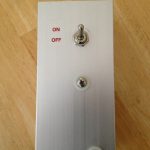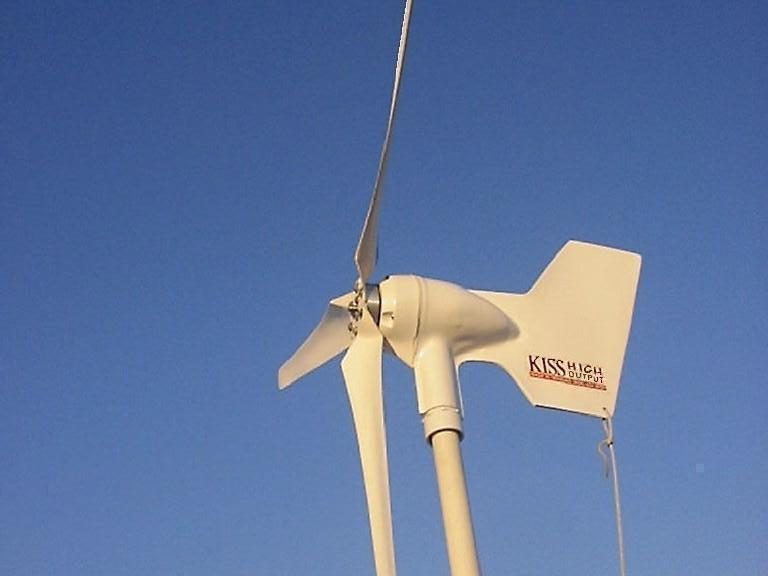“The KISS wind generator is a proven design that makes lots of power quietly in 7 to 25 knots perfect for Caribbean and tropical sailors and RV dry-campers who need to be electrically independent.” (Quote from the original KISS owners manual by Doug Billings).
History
Doug started building wind generators before he left Toronto to go cruising. They were fairly simple, but worked well enough that others asked him to build more. He left for the islands, landing in the British Virgin Islands, and started building what he called the “Doug Bugger” (presumably named after another popular generator at the time, the Wind Bugger). These were typical of the time, using “tape drive motors”, which were 12 volt, brush type motors used for big computers. In 1994, he started building wind generators in Trinidad, with the KISS coming out in early 1998.
Libbie and I met Doug while we were in Trinidad. We put one on our boat and sailed to the Grenadines for testing. It worked well. We sailed back to Trinidad, and made an agreement that we would sell the kiss in the USA. If you went to a sailboat show between 1998 and 2014, we may have met!
In 2011 he agreed to sell us all rights to the KISS wind generator. After all equipment was shipped to the US, Doug died aboard his boat.
I started building the KISS with some upgrades, and did so until about 2016, when I decided the learning curve was too steep. We have all the parts, and I still make blades. CruiseRO in San Diego now owns the rights and may start building them again.
Technical Info
The KISS is a permanent magnet alternator, using neodymium iron boron (rare earth) magnets. These magnets make such a strong magnetic field that field coil (electro magnets) and the associated brushes are not necessary. Rectification (changing the A/C from the generator to D/C) occurs outside the housing, typically near the battery, so there is very little voltage drop (lost energy) in the three wires that come down the pole. We use a commonly available rectifier out of a car.

PARTS
Magnets: There are a total of six magnets, three “north” and three “south”. They are installed such that the polarity alternates. There have been three or four different magnets used in the KISS. The earliest ones (up to about the year 2000) were about 2 inches long, and about 1/2 inch (almost) square in cross section. I have a few used ones. The newest magnets are arced, fit all round magnet cylinders, and these we have in stock. $17/ea (3 north and 3 south required).
Bearings: 6203 with rubber seals. The ones I use have high temperature grease and class C clearance with contactless seals (for less drag), but any good quality 6203 with two rubber seals will work. If you must get them elsewhere (and you can-pretty much anywhere in the world) use the best quality you can find. Don’t use cheap bearings! I’ve seen cheap ones last a very short time. We use NTN, here’s a review: “In testing the NTN bearings are generally the best irrespective of which seal is put on them. Their technical support is also very good (especially in the UK). The vast majority of NTN’s 6000 series bearings are made in Japan and they are sticklers for quality control. The only issue with NTN is supply.” Other manufacturers that make good bearings: SKF, Timken, NSF. If you order from me, a short piece of 7/8 SS tube (an “installation tool”) is included. $10/ea. Call to order (727) 943-0424
Blades: The blades are made with 8 layers of glass and one layer of kevlar/carbon fiber twill. They are painted with Alwgrip. The leading edge is covered with helicopter tape. The blades are balanced before shipping. $350 Call to order. (727) 943-0424
Bearing Seats: The bearing seats go between the outer races of the bearings and the generator housing. They are 1/4 inch thick silicone rubber (since about 2005), hand cut to shape. If yours are black in color, they need to be replaced. The newer ones are white or whitish in color and higher density to help center the bearings. $4.50/each
Freewheeling
I was talking to a KISS owner the other day. He had recently purchased a boat with a KISS wind generator installed. He said that there were three other KISSes in his marina, and that all the owners had told him that it was necessary to turn the generator out of the wind and tie it down when the winds get over 25 knots and the generator goes into freewheel. Apparently, this rumor has become common knowledge, and like much common knowledge, is untrue.
Why and How
All wind generators have to have some way of preventing overheating. Most modern marine wind generators use rare earth magnets, which are sensitive to overheating. Even older generators with earlier magnets can loose their magnetism if they get hot enough. Manufacturers use a lot of different techniques to prevent overheating. On the KISS, we use two thermal sensors inside the housing that are bi-metalic discs that open the circuits, stop energy production, and allow the generator to cool. When both are open, the output drops to zero, and the generator turns much faster than normal, causing additional noise and vibration. When one opens, the output is unbalanced, and the generator vibrates more than normal and the output drops by 2/3.
The on-off switch on the KISS connects the coil windings in the stator (shorts them out), creating a very large electrical (and thereby mechanical) load. When the circuits are opened by the thermal sensors, the coils cannot be shorted, and so the on-off switch will not turn the generator off when it is freewheeling.
What to do
There are more than one way to deal with this;
1) Do Nothing. When the KISS cools, it will start making power again. It will be making more noise and vibration while freewheeling. It will not be damaged. The thermal sensors we use are rated for something like 500,000 on-off cycles. We were stuck in 30 – 50 knots winds off shore with no engine or useable sails (it’s a long story). The KISS kept the SSB/ham, all the deck lights, and VHF radio going all night, cycling on and off it averaged 11 amps.
3) When the winds get up to a steady or average 25 knots, pull the generator part way out of the wind with a tether attached to the tailfin. In order to avoid approaching rapidly spinning blades, the tether should be set up before hand. We sat in the Tobago Keys for a few days with nothing but a submerged reef and 3000 miles between us and Africa. Winds were well above 25 knots. As the boat sailed around on the anchor, the wind generator (pulled part way out of the wind) would speed up or slow down, but it never went into freewheel. On a dark and stormy night, alone in the cockpit, without the additional tether rigged, I would probably go for options one or two.
2) Turn the switch off and wait. The KISS will cool, and when the thermal sensors close, it will shut off.
TROUBLESHOOTING
KISS doesn’t turn freely: To determine if the problem is inside the generator, disconnect the three wires at the switch. Measure the resistance with an ohmmeter on the lowest scale. It should be about 5 – 6 ohms between each pair of the wires. If the generator turns more freely with the wires disconnected, then the problem is the switch, rectifier or short between the switch and battery. The most likely of these is a shorted rectifier, see: https://www.youtube.com/watch?v=pzoh7rhIExQ The production quality is poor, but the info is good. You can test how much torque is required to turn the shaft by wrapping string around the shaft, then pull on it with a scale (like the kind a fisherman might use). A KISS with new bearings typically requires 7-9 pounds of force. Used KISS will be 5 -7 pounds.
